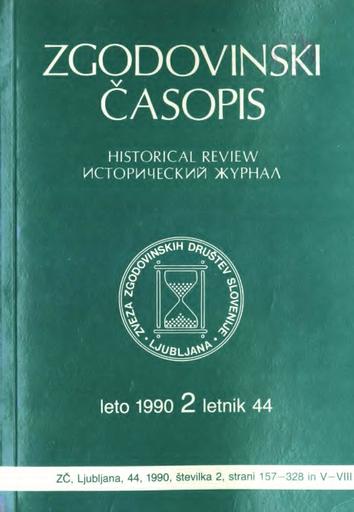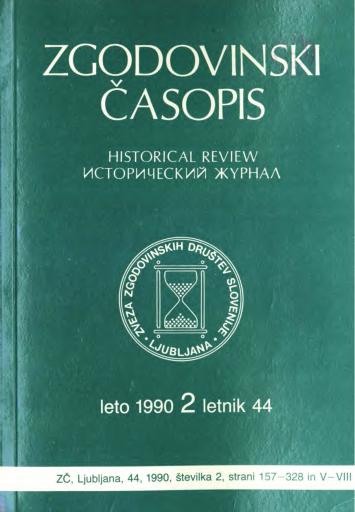/
Periodicals
/
Zgodovinski časopis
Family in Dolina / San Dorligo della Valle by Triest in the 19th Century

Author(s):Marta Verginella
Co-author(s):Vasilij Melik (odg. ur.)
Year:1990
Publisher(s):Zveza zgodovinskih društev Slovenije, Ljubljana
Source(s):Zgodovinski časopis, 1990, št. 2
Language(s):slovenščina
Type(s) of material:text
Keywords:Dolina pri Trstu, družina, prebivalstvo, demografski razvoj, etnologija, socialna zgodovina, ekonomska zgodovina, 19.st.
Rights:

This work by Marta Verginella is licensed under Creative Commons Attribution-NonCommercial-NoDerivs 4.0 International
Files (1)

Name:ZGODOVINSKI_CASOPIS_LETO_1990_LETNIK_44_STEVILKA_2.pdf
Size:9.33MB
Format:application/pdf
Permanent link:https://hdl.handle.net/11686/file135
Description
The authoress deals with development of a family and its structure. The village community consisted mostly of small farmer families, who were beside farming occupied also with baking and selling of their good bread (the so-called »krušarstvo«). The data, taken from the parish registers, indicate that demographic changes are in close mutual relation with economic and social changes. Typology of a family and marriages is determinated by the estate, and also by the number of adult family members. A multi-strata view into a family life makes possible also the analysis of the most important periods of life of an individual (birth, marriage, death). Both, family and collective relations changed in Dolina at the end of the 19th century, when the industrial influence of Triest increased.
Metadata (12)
- identifierhttps://hdl.handle.net/11686/14121
- title
- Družina v Dolini pri Trstu v 19. stoletju
- Family in Dolina / San Dorligo della Valle by Triest in the 19th Century
- creator
- Marta Verginella
- contributor
- Vasilij Melik (odg. ur.)
- subject
- Dolina pri Trstu
- družina
- prebivalstvo
- demografski razvoj
- etnologija
- socialna zgodovina
- ekonomska zgodovina
- 19.st.
- description
- The authoress deals with development of a family and its structure. The village community consisted mostly of small farmer families, who were beside farming occupied also with baking and selling of their good bread (the so-called »krušarstvo«). The data, taken from the parish registers, indicate that demographic changes are in close mutual relation with economic and social changes. Typology of a family and marriages is determinated by the estate, and also by the number of adult family members. A multi-strata view into a family life makes possible also the analysis of the most important periods of life of an individual (birth, marriage, death). Both, family and collective relations changed in Dolina at the end of the 19th century, when the industrial influence of Triest increased.
- Avtorica obravnava razvoj družine in njene strukture v Dolini (San Dorligo della Valle) pri Trstu. Vaško skupnost sestavljajo večinoma družine malih kmetov, ki se poleg kmetovanja ukvarjajo tudi s krušarstvom. Iz župnijskih matičnih knjig povzeti podatki kažejo, da demografske spremenljivke delujejo v tesnem razmerju z gospodarskimi in družbenimi spremembami. Tipologijo družine in poročne zveze določa posest, a tudi število odraslih članov. Večplasten vpogled v družinsko življenje omogoča tudi analiza najpomembnejših etap posameznikovega življenja (rojstvo, poroka, smrt). Tako družinska kot kolektivna razmerja se v Dolini spremenijo ob koncu 19. stoletja, ko se poveča industrijski vpliv Trsta.
- publisher
- Zveza zgodovinskih društev Slovenije
- date
- 1990
- type
- besedilo
- language
- Slovenščina
- isPartOf
- rights
- license: ccByNcNd
Citirano v (2)
| Tipologija | Avtor(ji) | Naslov | Kraj | Založba | Leto |
|---|---|---|---|---|---|
| 2.01 Znanstvena monografija | Hren Medved, Alenka | Premog, železnica, terme in pivo : modernizacija in demografski razvoj Laškega v dolgem 19. stoletju | Ljubljana | Inštitut za novejšo zgodovino | 2021 |
| 1.16 Uvodnik, predgovor, spremna beseda | Hren Medved, Alenka | Revno trško in podeželsko prebivalstvo Laškega v 19. stoletju | Ljubljana | Inštitut za novejšo zgodovino | 2022 |
